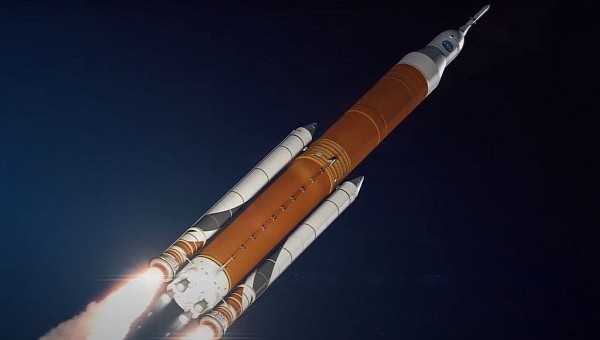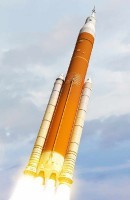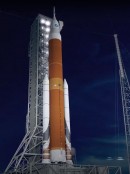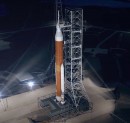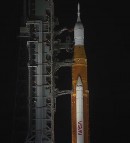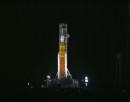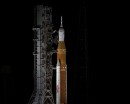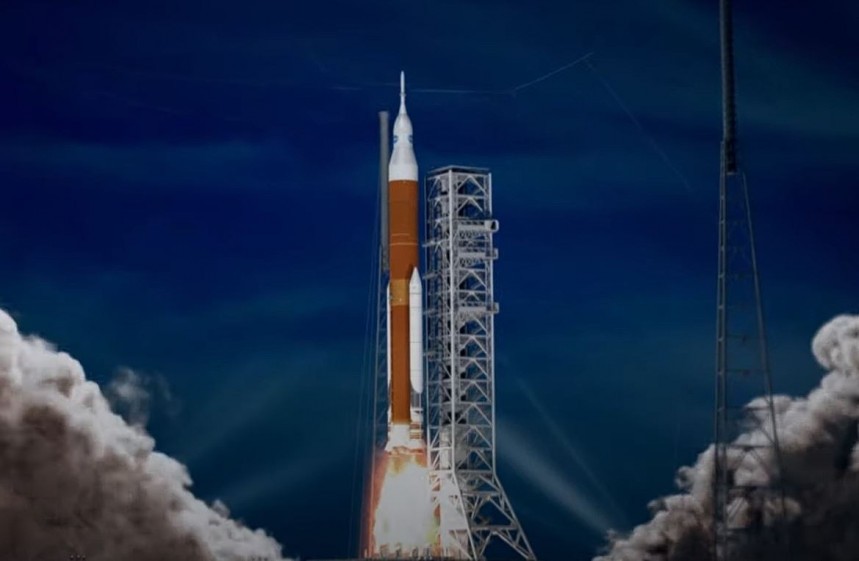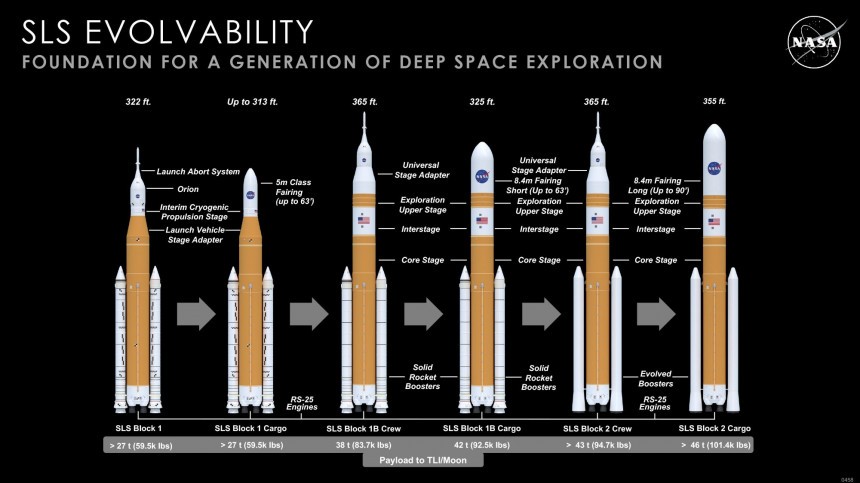Many people were very mean to NASA's SLS super-heavy booster when it saw back-to-back-to-back consecutive launch scrubs caused by everything from faulty engine temperature sensors to leaky hydrogen fuel tank seals and, finally, the largest Floridian hurricane in recorded history.
In the end, it took both of Artemis I's solid rocket boosters roaring to life to render negative narratives about the SLS vaporized under a sea of brilliant, barely-controlled chemical explosions. In its original un-crewed Block 1 configuration, the 320-plus foot tall, 8.8 million pounds thrust-producing SLS performed nothing short of flawlessly.
But do you want to know what's extra super amazing about SLS? It's only going to get bigger, better, and more powerful from here. Keep in mind the crewed configuration of the Block 1 SLS has yet to fly. Even so, NASA aims to play the long game with its flagship booster.
As the amount of hardware that NASA and the ESA plan to put on the Lunar surface and in its orbit will one day overwhelm the capabilities of their current mightiest rocket. When this happens, NASA will be prepared. The joint NASA/ESA Artemis program currently plans to use the crewed SLS Block I rocket for the Artemis II and III missions.
In the case of Artemis II, it's planned to be a circumnavigational mission and, therefore, won't include a Lunar lander segment. But as for Artemis III, the circumstances are far more complicated. Though the Lunar lander duties for this mission will be entrusted to SpaceX's Starship Human Landing System, that doesn't mean the SLS won't need to haul a bigger payload.
If all goes according to plan, Artemis III will be the first crewed space mission to dock with an orbital service station around another heavenly body. On the following Artemis IV mission, SLS Block 1B will be tasked with bringing the vital International Habitation Module to the Gateway station as its first major infrastructure upgrade since its deployment to orbit via a Falcon Heavy booster rocket sometime before the mission.
For this reason, Artemis IV will be the debut mission of the SLS Block 1B. What will be the largest, heaviest, most powerful, undisputed heavyweight champion of crew-capable chemical booster rockets. With more powerful and efficient Aerojet Rocketdyne RS-25E engines, we doubt anyone was mocking the SLS for its "warmed up space shuttle technology" after Artemis I's spectacular launch.
But if they are, the SLS Block 1B will certainly quiet critics in a hurry. Or at least its estimated payload to Trans-Lunar Injection (T-LI) of 38 tons (87,000 lbs, 39,462 kg) for the crew variant and 42 tons (92,500 lbs, 41,957 kg) for the cargo configuration will. We're starting to reach some seriously uncharted territory when it comes to space-fairing rockets here.
Upgraded Aerojet Rocketdyne RL-10 Upper Stage engines will ensure the dramatic flash of the SLS Block 1B's core stage isn't the only item bristling with new technology. It'll all support an added Exploration Upper Stage (EUS) theoretically capable of taking an Orion crew capsule beyond the influence of the Moon-Earth binary system. Inevitably, that means it could theoretically get humans to Mars and possibly many places besides.
The EUS will also bring the SLS Block 1B Crew vehicle to a total of two feet (0.6 meters) taller than the tallest super-heavy booster rocket ever launched, the iconic Saturn V from the Apollo Era. Unlike the old Saturn leviathan, the SLS is designed to be more sustainable and slightly more re-useable than the 13 missions the old Apollo program managed to squeeze out.
But with all this lifting power now on the table, one can't help but wonder how what the upper limits of SLS's abilities truly are. Proposals have been on the table at NASA in the recent past to utilize the SLS platform for the next generation of deep-space interplanetary exploration probes.
Un-crewed probe missions to far-off destinations like Jupiter's moon Europa, Saturn's moon Enceladus, the Neptunian system, and even a Voyager 1/Voyager 2-style interstellar mission which could potentially depart the bounds of our solar system in a fraction of the time it took previously.
Despite all the cost overruns, torrents of press criticism, and multiple failed launch attempts, it's hard to argue against the potential for discoveries that come with a booster rocket as awesomely powerful as the SLS. To get anything more powerful than this, you might as well just throw chemical rockets away and go full-nuclear. But given all the pesky radiation, there's a sense the SLS will do just fine for now.
Check back soon for more from Celebration Month 2022 here on autoevolution.
But do you want to know what's extra super amazing about SLS? It's only going to get bigger, better, and more powerful from here. Keep in mind the crewed configuration of the Block 1 SLS has yet to fly. Even so, NASA aims to play the long game with its flagship booster.
As the amount of hardware that NASA and the ESA plan to put on the Lunar surface and in its orbit will one day overwhelm the capabilities of their current mightiest rocket. When this happens, NASA will be prepared. The joint NASA/ESA Artemis program currently plans to use the crewed SLS Block I rocket for the Artemis II and III missions.
In the case of Artemis II, it's planned to be a circumnavigational mission and, therefore, won't include a Lunar lander segment. But as for Artemis III, the circumstances are far more complicated. Though the Lunar lander duties for this mission will be entrusted to SpaceX's Starship Human Landing System, that doesn't mean the SLS won't need to haul a bigger payload.
For this reason, Artemis IV will be the debut mission of the SLS Block 1B. What will be the largest, heaviest, most powerful, undisputed heavyweight champion of crew-capable chemical booster rockets. With more powerful and efficient Aerojet Rocketdyne RS-25E engines, we doubt anyone was mocking the SLS for its "warmed up space shuttle technology" after Artemis I's spectacular launch.
But if they are, the SLS Block 1B will certainly quiet critics in a hurry. Or at least its estimated payload to Trans-Lunar Injection (T-LI) of 38 tons (87,000 lbs, 39,462 kg) for the crew variant and 42 tons (92,500 lbs, 41,957 kg) for the cargo configuration will. We're starting to reach some seriously uncharted territory when it comes to space-fairing rockets here.
Upgraded Aerojet Rocketdyne RL-10 Upper Stage engines will ensure the dramatic flash of the SLS Block 1B's core stage isn't the only item bristling with new technology. It'll all support an added Exploration Upper Stage (EUS) theoretically capable of taking an Orion crew capsule beyond the influence of the Moon-Earth binary system. Inevitably, that means it could theoretically get humans to Mars and possibly many places besides.
But with all this lifting power now on the table, one can't help but wonder how what the upper limits of SLS's abilities truly are. Proposals have been on the table at NASA in the recent past to utilize the SLS platform for the next generation of deep-space interplanetary exploration probes.
Un-crewed probe missions to far-off destinations like Jupiter's moon Europa, Saturn's moon Enceladus, the Neptunian system, and even a Voyager 1/Voyager 2-style interstellar mission which could potentially depart the bounds of our solar system in a fraction of the time it took previously.
Despite all the cost overruns, torrents of press criticism, and multiple failed launch attempts, it's hard to argue against the potential for discoveries that come with a booster rocket as awesomely powerful as the SLS. To get anything more powerful than this, you might as well just throw chemical rockets away and go full-nuclear. But given all the pesky radiation, there's a sense the SLS will do just fine for now.
